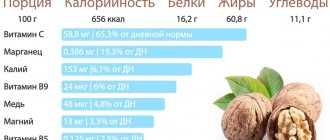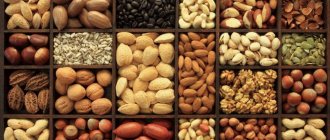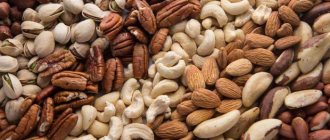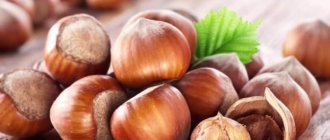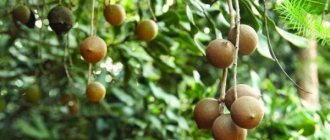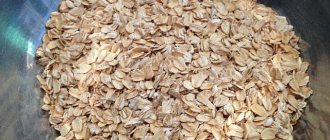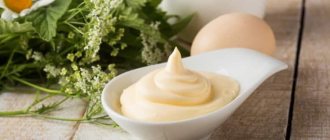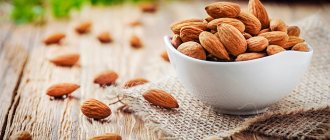Nut calorie table
Each product has its own calorie content, for example, the calorie content of a walnut is 647-705 kcal per 100 grams, the calorie content of almonds is 583-650 kcal/100 g, and the calorie content of hazelnuts, everyone’s favorite delicacy, is 651-704 kcal per 100 grams. The kernels contain large amounts of protein, fat and carbohydrates. Let's take a closer look at the calorie content of nuts; the table will show a comparison of data between types.
| Apricot kernel | 14.0 | 27.7 | 56.3 | 440 | |
| Peanut | 26.3 | 45.2 | 9.9 | 622 | |
| Dried peanuts | 29.2 | 50.2 | 10.8 | 611 | |
| Brazilian nut | 14.3 | 66.4 | 4.8 | 656 | |
| Beech nut | 6.2 | 50.0 | 33.5 | 576 | |
| Walnut | 15.2 | 65.2 | 7.0 | 654 | |
| Acorn | 24.0 | 20.7 | 15.7 | 387 | |
| Cocoa beans | 12.8 | 53.1 | 9.5 | 565 | |
| Roasted chestnut | 3.2 | 2.2 | 33.8 | 182 | |
| Canned chestnut | 3.4 | 2.2 | 50.0 | 213 | |
| Fresh chestnut | 3.4 | 3.0 | 30.6 | 166 | |
| Pine nuts | 15.6 | 56.0 | 28.4 | 680 | |
| Cedar cake | 31.0 | 19.0 | 33.0 | 432 | |
| Cashew | 18.5 | 48.5 | 22.5 | 600 | |
| Roasted cashews | 17.5 | 42.2 | 30.5 | 572 | |
| Coconut | 3.4 | 33.5 | 6.2 | 354 | |
| Sesame | 19.4 | 48.7 | 12.2 | 565 | |
| Black sesame | 19.4 | 48.4 | 12.2 | 565 | |
| Poppy | 17.5 | 47.5 | 2.0 | 505 | |
| Sweet almonds | 18.6 | 57.7 | 16.2 | 645 | |
| Kola nut | 7.9 | 0.1 | 5.2 | 150 | |
| Kukui nut | 7.9 | 75.8 | 5.2 | 620 | |
| Hazelnut | 13.1 | 62.6 | 9.3 | 653 | |
| Macadamia nut | 7.9 | 75.8 | 5.2 | 718 | |
| Pecan | 9.2 | 72.0 | 4.3 | 691 | |
| Walnut drank | 10.8 | 79.6 | 4.0 | 719 | |
| Seychelles nut Coco de mer | 3.3 | 33.5 | 6.2 | 354 | |
| Chilim nut | 11.9 | 3.4 | 55.4 | 200 | |
| Rape | 30.8 | 43.6 | 7.2 | 544 | |
| Mustard seeds | 25.8 | 30.8 | 23.4 | 474 | |
| Hemp seeds | 20.0 | 32.5 | 14.0 | 429 | |
| Flax seeds | 18.3 | 42.2 | 28.9 | 534 | |
| Fenugreek seeds | 23.0 | 6.4 | 58.3 | 323 | |
| Dill seeds | 16.0 | 14.5 | 55.1 | 305 | |
| Fennel seeds | 15.8 | 14.8 | 52.3 | 345 | |
| Chia seeds | 16.5 | 30.7 | 42.1 | 512 | |
| Melon seeds | 17.6 | 47.3 | 14.6 | 555 | |
| Sunflower seeds | 20.7 | 52.9 | 3.4 | 578 | |
| Pumpkin seeds | 24.5 | 45.8 | 4.7 | 556 | |
| Pistachios | 20.0 | 50.0 | 7.0 | 556 | |
| Hazelnut | 16.1 | 66.9 | 9.9 | 704 | |
| Hemp kernel | 30.0 | 41.0 | 10.7 | 514 | |
| The nutritional value | 519.1 kcal | 25 gr | 2.8 g | 45.4 g | |
| –> –> –> –> Peanut | The nutritional value | 552 kcal | 26.3 g | 9.9 g | 45.2 g |
| –> –> –> –> Cherry-kernel | The nutritional value | 422.1 kcal | 21.9 g | 16 g | 30.5 g |
| –> –> –> –> Mustard seed | The nutritional value | 474 kcal | 25.8 g | 23.4 g | 30.8 g |
| –> –> –> –> Cocoa beans | The nutritional value | 565.3 kcal | 12.8 g | 9.4 g | 53.2 g |
| –> –> –> –> Pine nut | The nutritional value | 673 kcal | 13.69 g | 13.08 g | 68.37 g |
| –> –> –> –> Hemp seed | The nutritional value | 372.9 kcal | 20.1 g | 32.5 g | |
| –> –> –> –> Sesame seed | The nutritional value | 565 kcal | 19.4 g | 12.2 g | 48.7 g |
| –> –> –> –> Hazel | The nutritional value | 653 kcal | 13 g | 9.3 g | 62.6 g |
| –> –> –> –> Poppy seed | The nutritional value | 556 kcal | 17.5 g | 14.5 g | 47.5 g |
| –> –> –> –> Almonds | The nutritional value | 609 kcal | 18.6 g | 13 g | 53.7 g |
| –> –> –> –> Walnut | The nutritional value | 656 kcal | 16.2 g | 11.1 g | 60.8 g |
| –> –> –> –> Cashew nut | The nutritional value | 600 kcal | 18.5 g | 22.5 g | 48.5 g |
| –> –> –> –> Nutmeg | The nutritional value | 556.3 kcal | 20 gr | 7 g | 50 gr |
| –> –> –> –> Sunflower seed | The nutritional value | 601 kcal | 20.7 g | 10.5 g | 52.9 g |
| –> –> –> –> Rapeseed seed | The nutritional value | 544 kcal | 30.8 g | 7.2 g | 43.6 g |
| –> –> –> –> Plum-kernel | The nutritional value | 475.8 kcal | 28.5 g | 40.2 g | |
| –> –> –> –> Pistachios | The nutritional value | 556.3 kcal | 20 gr | 7 g | 50 gr |
| –> –> –> –> Hazelnut | The nutritional value | 651 kcal | 15 g | 9.4 g | 61.5 g |
| –> –> –> –> Cotton seed | The nutritional value | 496.9 kcal | 34.5 g | 8.1 g | 36.5 g |
| –> –> –> –> Roasted peanut kernel | The nutritional value | 626 kcal | 26 g | 13.4 g | 52 g |
| –> –> –> –> Roasted almond kernels | The nutritional value | 642 kcal | 22.4 g | 12.3 g | 55.9 g |
| –> –> –> –> Roasted hazelnut kernel | The nutritional value | 703 kcal | 17.8 g | 9.4 g | 66.1 g |
| Squirrels | Carbohydrates | ||||
| Pecan | |||||
| Cedar | |||||
| Brazilian | |||||
| Gretsky | |||||
| Hazelnut | Squirrels | Carbohydrates | |||
| Almond | |||||
| Cashew | |||||
| Pistachios | |||||
| Peanut | |||||
| No. | Name of the fruit | Squirrels | Fats | Carbohydrates | Kcal |
| 1 | Chestnut (fresh) | 3.4 | 3 | 30.6 | 166 |
| 2 | Chestnut (roasted) | 3.2 | 2.2 | 33.8 | 182 |
| 3 | Coconut | 3.4 | 33.5 | 29.5 | 380 |
| 4 | Peanut | 26.3 | 45.2 | 9.9 | 551 |
| 5 | Pistachios | 20 | 50 | 7 | 556 |
| 6 | Brazilian | 14 | 66 | 12 | 565 |
| 7 | Roasted cashews | 17.5 | 42.2 | 30.5 | 572 |
| 8 | Almond | 18.6 | 53.7 | 13 | 609 |
| 9 | Dried peanuts | 29.2 | 50.2 | 10.8 | 611 |
| 10 | Cedar | 11.6 | 61 | 19.3 | 629 |
| 11 | Cashew fresh | 25.7 | 54.1 | 13.2 | 643 |
| 12 | Manchurian | 28.6 | 61 | 7.7 | 643 |
| 13 | Gretsky | 15.2 | 65.2 | 11.1 | 648 |
| 14 | Pecan | 9.2 | 72 | 4.3 | 691 |
| 15 | Hazelnut | 16.1 | 66.9 | 9.9. | 704 |
| 16 | Macadamia | 7.9 | 75.7 | 5.2 | 718 |
The table shows that most nuts are fats, so before you throw a handful of delicious treats into your morning oatmeal with dried fruit, you should familiarize yourself with these data. The calculation is based on 100 grams of product. The daily norm for a person is a handful. Do not exceed the dose, especially if you are on a diet. For self-control, take the required dose and remove the excess, mix with food or grind in a coffee grinder; not only is it tasty and quickly digested, but the beneficial components are better absorbed by the walls of the stomach. People and athletes who are losing weight should choose low-calorie nuts:
The kernels must be in their pure form without the addition of salt, sugar, glaze or chocolate. Nuts can be eaten for breakfast with oatmeal and fruit or as a snack before lunch, when the body processes carbohydrates best and they are not deposited in our sides.
Chemical composition, calorie content, nutritional and energy value
Walnuts have a fairly balanced composition, including almost all the vitamins and minerals, fats, proteins and carbohydrates that a person needs. Next, its mineral composition is discussed in detail.
How much protein, fat, carbohydrates, calories?
By calculating the KBZHU and BZHU of the purified product, you can see how much fat, protein, carbohydrates and kilocalories are contained in 100 grams of nuts:
- 654 kcal;
- proteins – 16.2 g;
- fats – 60.8 g;
- carbohydrates – 11.1 g;
- dietary fiber – 6.1 g;
- water – 3.8 g.
Most nut lovers mistakenly think that the calorie content of young walnuts is much lower, since they are less bitter. But this is due to the fact that more mature nuts receive more oxygen through the shell, which reacts with acids, giving a characteristic flavor. Otherwise, the content of nutrients is unchanged.
In one nut
Based on the total calorie content of 100 grams of the product without the shell, it is easy to calculate what the energy value of 1 piece is and how many calories it contains. On average, 1 g of product accounts for about:
- 6.54 kcal;
- 0.162 g proteins;
- 0.608 g fat;
- 0.111 g carbohydrates.
One walnut weighs approximately 5 g. Thus, we get:
| Quantity (pcs.) | Squirrels | Fats | Carbohydrates | Calories |
| 1 | 0.81 g | 3.04 g | 0.55 g | 32.7 kcal |
| 0,5 | 0.405 g | 1.52 g | 0.275 g | 16.35 kcal |
| 2 | 1.62 g | 6.08 g | 1.1 g | 65.4 kcal |
| 3 | 2.43 g | 9.12 g | 1.65 g | 98.1 kcal |
| 5 | 4.05 g | 15.2 g | 2.75 g | 163.5 kcal |
| 6 | 4.86 g | 18.24 g | 3.3 g | 196.2 kcal |
| 10 | 8.1 g | 30.4 g | 5.5 g | 327 kcal |
From here you can calculate the daily norm. A person can eat 4-6 pieces of a product such as walnuts without harming their figure.
What substances does it mainly consist of?
Walnuts are almost half fat, so they can very quickly satisfy hunger and saturate the body. The optimal daily dose is 30 - 50 g, that is, no more than 5 pieces.
Amount of useful vitamins
The following is detailed information about the composition of walnut kernels, whether they contain vitamin C and what other substances are contained in 100 grams of the product:
| A (beta-carotene) | 0,05 |
| B1 (thiamine) | 0,4 |
| B2 (riboflavin) | 0,13 |
| B9 (Folic acid) | 77 |
| E (tocopherol) | 23 |
| PP (niacin) | 1 |
| C (ascorbic acid) | 3 |
Contents Omega
Like most plant foods, these nuts contain no cholesterol and are a natural source of Omega-3. This element helps improve memory, and in combination with iodine and selenium ensures normal brain function.
Glycemic index
The glycemic index of walnuts is 15, being valuable for the diet of diabetics
The American Diabetes Association recently shared important and exciting news with the entire global community. Scientists have published the results of a study of the effect of nuts on the body
It has been established that regular consumption of such products in type 2 diabetes helps reduce the level of glucose and insulin in the blood, as well as low-density cholesterol. Walnuts contain carbohydrates that break down slowly and smoothly in the intestines and do not provoke sudden surges in glucose.
Macro- and microelements (mg per 100 grams)
The table below shows what nuts are rich in, how much iron they contain, and what else useful is contained in the product.
| Zinc | 2,5 |
| Fluorine | 0,7 |
| Copper | 0,5 |
| Manganese | 2 |
| Iron | 2,3 |
| Phosphorus | 550 |
| Sodium | 3 |
| Magnesium | 200 |
| Calcium | 120 |
| Potassium | 665 |
Walnuts contain 10 essential amino acids:
- tryptophan – improves sleep;
- phenylalanine – improves memory;
- isoleucine – promotes muscle tissue restoration;
- arginine – cleanses the liver of toxins;
- valine – necessary to maintain normal nitrogen balance;
- histidine – responsible for tissue growth;
- leucine – reduces blood sugar;
- threonine – participates in collagen synthesis;
- lysine – promotes calcium absorption;
- methionine – protects against radiation.
Weight of 1 walnut without shell
Nuts contain a large amount of vitamins and minerals. They have long been used to strengthen the immune system and improve the functioning of the circulatory system. The core has a positive effect on brain function. That is why a person should include it in his diet.
The product is high in calories
It is important to find out in advance how much a walnut without shell weighs. One hundred grams of product contains more than 650 kcal
Excessive consumption leads to the accumulation of excess weight.
The situation is not only dangerous, but can lead to serious consequences in the future.
The weight of one nut can be calculated if you know its variety and size. On average, the figure ranges from 10 to 15 grams. The weight of the shell itself is about the same. However, it is not taken into account when making final calculations.
If we want to calculate the weight of an average kernel, it will be no more than seven grams. A beneficial effect will be provided if a person eats no more than 40 grams every day.
That is why the number of cores should not be more than 8 pieces.
1 regular walnut is equivalent to 30 kcal. When taking into account the maximum volume per day, you can consume no more than 250 kcal of the product.
Additionally, when calculating, the following calculation scheme is often used:
- Take a standard 250 ml glass.
- Fill it completely with kernels.
- Their weight will be approximately 165 grams.
Weight of other nuts compared to walnuts
Each variety of nuts is characterized by the presence of special vitamins and minerals. They have a positive effect and significantly reduce the amount of cholesterol in the blood. Weight and nutritional value also vary
The presence of an allergic reaction will also need to be taken into account. We should not forget that nuts often provoke individual intolerance
Cedar
This type of nut is extracted from cones. One such “house” can hold up to 150 seeds. The kernels are light in weight and will need to be cleaned in a special way. When determining mass, one should rely on the following criteria:
- One kernel will not weigh more than a quarter of a gram. The weight of the shell is two times less.
- A regular tablespoon can hold approximately 30 grams.
- One 250 ml glass contains about 190 grams of kernels.
Small nuts have a large supply of vitamins E and B. With their regular use, it is possible to prevent cell aging
However, it is important to remove the shell in time. Otherwise, the contents will quickly deteriorate
Hazelnut (hazelnut)
Through calculation and analysis of statistical data, it was possible to establish that the weight of one peeled fruit is 1 gram
However, when creating a menu, it is recommended to take into account the following calorie parameters:
- One hundred grams of pure product contains almost 700 kcal.
- From this we can conclude that one hazelnut contains no more than 7 kcal.
The fruit kernels have a wide range of beneficial properties. Regular inclusion in the menu improves the functioning of the immune system. Additionally, it was found that hazelnuts are capable of removing harmful toxins from the human body. Regular consumption is effective in preventing the formation of cancer cells.
Almond
Almonds are characterized by the presence of a large amount of fats and acids that are beneficial to the body. It also contains vitamin E, which is considered one of the most effective natural antioxidants. Thanks to its positive effect on the body, it is possible to prevent aging and the development of harmful viruses and bacteria.
Almond peel is not heavy, but it is not recommended to take it into account when calculating. The weight of one kernel ranges from 1 to 5 grams. A regular tablespoon holds 30 grams of product, which equates to 180 kcal.
Muscat
The nut is used as a spice in almost all countries of the globe. Even half a kernel can change the flavor of a dish and add elegance to it. Peeled walnuts, unfortunately, do not have similar properties. Spicy properties can only be obtained with proper ventilation of the product. During the cooking process, the following parameters should be taken into account.
- The weight of one peeled fruit is no more than 5 grams.
- A regular teaspoon contains up to 6 grams of product.
Nutmeg is characterized by a specific burning taste. Its excessive consumption can have a negative effect on the human body. The situation is dangerous and can result in severe food poisoning. That is why the addition of spices must be dosed.
Weight of walnuts, hazelnuts, almonds, kushew, peanuts
Nutritionists say that nuts are an important component of any person’s diet. They contain a large amount of minerals and vitamins. By consuming the daily amount per day, a person will begin to feel better within a few days.
Doctors advise eating a handful of nuts a day, but everyone’s palms are different: some have more, some have less.
Therefore, you need to know how many nuts you can eat per day in grams and how much one walnut without shell, almonds, peanuts, hazelnuts and other nuts weighs.
Hazelnut
Daily use:
- improves the condition of blood vessels;
- helps get rid of anemia (low hemoglobin content in the blood);
- the heart muscle is strengthened (heart function is normalized);
- blood pressure is normalized;
The calorie content of hazelnuts is about 700 kcal per 100 grams. 1 nut weighs about 1-2 grams. Based on this, it is easy to calculate the calorie content of hazelnuts.
1 ripe fruit contains about 7-10 kcal.
You can consume no more than 50 grams of fruits per day (the ideal daily norm is 30 grams).
The volume of 1 piece of hazelnut is, on average, about 1-1.5 cm.
Peanut
Many people think of peanuts as a nut, but peanuts are actually legumes. The nut contains a large number of microelements that improve the condition of the body.
Peanuts become most beneficial when consumed daily. So, in order to eat nuts every day, Americans created a delicious dessert - peanut butter.
Weight:
- 1 raw, unpeeled nut weighs less than 1 gram (about 0.1-0.3 grams);
- 1 tablespoon of peanuts contains 11-12 grams;
- in 1 teaspoon – 4-6 g;
100 grams contain 550 kcal.
Size 1 piece in length – 1-1.4 cm.
In a regular glass (200-250 ml) – 130-140 grams of peanuts. Accordingly, half a glass of nuts weighs about 65-70 grams.
Cashew
Cashew is a nut that is used in many diets. Cashews quickly satisfy hunger and saturate the body with useful substances.
Ripe Indian nuts have a positive effect on men's health (increases sperm activity, improves potency). Affects the condition of the skin, nails and hair. A few weeks after eating cashews, your hair becomes better and has a vibrant shine. Including, Some women claim that eating cashews increases hair thickness.
Weight:
- 1 piece – 2-3 g;
- 1 tablespoon – 10-11 g;
100 grams contain 600 kcal. The daily norm is up to twenty-five grams.
Pivot table
Below is a table that contains the necessary data to strengthen the body with vitamins and minerals found in nuts.
| Weight (1 piece) | Weight (1 tbsp) | kcal per 100 g | Daily norm, g | |
| Walnut | With shell (unshelled nut) – 25-30 g Without shell – 5-10 g | 11 g | 656 kcal | 5-7 cores |
| Almond | 1-2 g | 8-10 g | 579 kcal | 30-50 gr |
| Hazelnut | 1-2 g | 700 kcal | 30-50 gr | |
| Peanut | 0.1-0.3 g | 11-12 g | 550 kcal | 15-20 cores (children 8-10) |
| Muscat | 3-8 g | 13-15 g | 556 kcal | 2-3 cores |
| Cashew | 2-3 g | 10-11 g | 600 kcal | 20-25 gr |
In order to get the maximum benefit from ripe nuts, you need to eat not just one type of fruit, but several. If it is not possible to eat nuts daily, it is recommended to buy nut mixtures, which are sold in any grocery store, 2-3 times a month.
Conclusion
Nuts bring invaluable benefits to the body. Only these fruits contain so many vitamins, minerals, healthy fats and acids. Using the daily dose, a person begins to feel better within a week.
Nuts increase immunity and strengthen the body. A person who eats nuts daily is less likely to suffer from viral and infectious diseases.
But in order for nuts not to harm the body, you need to know how much you can eat per day and how much each fruit weighs.
Contraindications
Despite the enormous benefits due to the composition of walnuts, it also has some contraindications. The daily portion recommended by doctors does not exceed 100 grams. Excessive consumption of this product can cause swelling of the throat, inflammation of the tonsils, and cerebral vascular spasm. People with high blood clotting should not get carried away with it. Diseases of the skin, intestines, and pancreas require prior consultation with a specialist. The abundance of vegetable protein in the nut sometimes causes an allergic reaction. There is also individual intolerance.
The undoubted benefits of walnuts make them a necessary addition to the daily human diet. It is necessary to choose only fresh nuts, without signs of mold or darkening. If you have serious illnesses, their use in food should be agreed with your doctor.
Walnut harm
The benefits and harms of nuts for the body, daily intake and composition
To prevent walnuts from causing harm, they must be stored correctly and not used for food at the slightest suspicion of spoilage. The shell should be dry without oily stains or visual defects; if you knock the nut against each other, the sound should be clear and loud. If the shell is peeled, the nut should be golden in color and have a pleasant smell without a hint of rancidity. If a walnut is not stored correctly, if it is allowed to become moldy or rancid, then instead of pleasure and benefit, treatment may be required.
In addition to making the right choice, you should pay attention to the following so that instead of a positive effect you do not get harm:
- For people who are obese, walnuts in large quantities are contraindicated;
- the nut should not be included in the diet if you are allergic to its components;
- Contraindications may include increased blood coagulation, eczema, psoriasis, neurodermatitis, poor blood clotting;
- disorders of the intestinal tract and inflammation of the pancreas.
It is necessary not to exceed the daily intake, otherwise walnuts will cause headaches, rashes, and stomach upset.
Average weight of one nut
The easiest way is to weigh the whole nut. Its weight will be about 10–20 g. About 30 varieties of this plant are included in the State Register of the Russian Federation. You can take 10 from this list to compare and get their average weight.
According to the data below, the mass of one fruit is (in grams):
- Aurora - 13;
- Arcade - 8.9;
- Dagestan - 13;
- Dachny - 9.3;
- Dawn of the East - 8.9;
- Codrene - 13.1;
- Marion - 12;
- Nadezhda - 12.6;
- Orion - 11;
- Peschansky - 14.8.
Pay attention to large, elongated fruits with a light shell. Their kernels are the largest
Whole walnuts range in width from 30.8 to 34.6 mm and length from 37 to 43.6 mm. Read also: How to store carrots in a city apartment
The arithmetic average of their weight is approximately 11.65 g. The hard shell can be thin with a large core or thick. Therefore, it is advisable to carry out weighing by clearing the kernels from it. If you buy fruits in shell, then keep in mind that its weight is about 40% of the total weight of the nut.
Weight without shell
The kernels, which often make up more than half the nut's mass, weigh between 5.5 and 14.8 grams. Small - about 5 g. If you take a medium nut, the weight will be 7-9 g. The weight of very large fruits can reach 13 g. A tablespoon of crushed kernels will weigh about 14 g. It all depends on how crushed they are.
Measuring kernels without weights:
- 1 half walnut – 2–4 grams;
- 50 halves - 100–200 grams.
How much does a bag of nuts weigh?
A freshly harvested pine nut in a standard burlap sack weighs about 40 kg. Such fruits still have a lot of natural moisture, mainly in the peel. After drying under natural conditions, approximately 2-3 months from the moment of collection, the bag of nuts will weigh 35 kg.
To sew the bag, you need to reduce its volume by tucking the edge. Plus, the seeds of cedar pine trees do not have the highest density compared to flour. If an ordinary bag weighs 50 kg, it means the product was soaked in water, or there is a weighting agent in the middle. In order not to be deceived by an unscrupulous seller, you should pour the nut into your container and make sure it is dry.
If a bag filled to the top weighs less than 30 kg, then most likely it contains “screenings” (an empty nut). An ordinary buyer will not immediately understand the difference, because the shell is intact and practically no different from seeds with a kernel. The only thing that can give it away is a slightly darker and cloudier color of the peel.
Walnuts
They are distinguished by a fairly high content of vitamin C. The composition is so balanced that it satisfies the body’s basic needs for vitamins and minerals, thereby preventing vitamin deficiency.
Vitamins and minerals in 100 grams of walnuts:
| Vitamins | mg per 100 g | Minerals | mg per 100 g |
| 0,008 | Potassium | 474 | |
| 0,39 | Phosphorus | 332 | |
| 0,12 | Magnesium | 120 | |
| 4,8 | Sulfur | 100 | |
| 0,8 | Calcium | 89 | |
| 0,8 | Chlorine | 25 | |
| 0,07 | Sodium | 7 | |
| 5,8 | Zinc | 2,5 | |
| 21 | Iron | 2 | |
| 2,7 | Iodine | 0,003 |
Be careful: excessive amounts can lead to allergic reactions; walnuts are not recommended for gastrointestinal problems. Walnuts reduce the risk of malignant tumors of the prostate and mammary glands. B vitamins and omega-3 fatty acids nourish the brain and improve memory. Tocopherol slows down the aging of cells and nourishes them. 4-5 nuts with honey can replace one of your meals, calm the nervous system, and help eliminate spasms.
rules for purchasing and processing raw materials
1. What is the yield of the walnut kernel in relation to the shell and membrane?
The percentage of pure kernel in a walnut is about 30-35%. Accordingly, from 3 kg of whole, dried nut you can get 1 kg of kernel. These are the indicators for processing the average nut accepted by the population. For high-quality walnuts, the kernel yield rate is noticeably higher - 35-45%, and for some varieties - even up to 50%. Therefore, high-quality nuts are much more valuable.
2. How to choose the right unshelled walnut for maximum kernel yield?
The selection of high-quality raw materials for further processing is the main stage in the nut business; the final yield of the product and, accordingly, income depend on this. Of course, one should not underestimate the role of processes such as procurement, storage, processing and sorting of nuts, because without their responsible execution it is impossible to achieve good results
And yet, the choice of raw materials plays a primary role. So, what should you pay attention to when purchasing walnuts? First of all, these are certain external criteria that visually help to recognize a quality nut.
2.1. Nice nut
light, has no chips, cracks or dark spots. The oblong shape is given preference over the round one, since it is believed that elongated nuts have a thinner shell and a larger kernel size. A good nut's shell should crack well and the kernel should separate from it without much effort. The shell should not be very hard, but at the same time it should not be too thin. The thin shell is easily damaged, resulting in chips and cracks, and parasites can easily penetrate the nut; it can become moldy or rot.
2.2. Nut to avoid:
–
thick-barked nut
(popular names – “greedy”, “dagger”, “cleaver”).
This is a nut in which the kernel has literally grown into the shell, and it is almost impossible to get a “butterfly” out of it, that is, a whole intact kernel. Due to the large amount of shell, these nuts usually weigh more, take a lot of time and effort to shell, and the result is a cheap product with a small percentage of the whole kernel. Therefore, in processing plants such raw materials are considered defective; - last year's nut
.
Such a nut weighs lighter, it is overdried, has a dark, shriveled kernel, and when cracked, it crumbles, so the whole kernel, a “butterfly,” is extremely difficult to get out of it. In addition, last year’s nuts have lost their taste and beneficial qualities; – wet nut.
This is an unripe nut that requires drying.
If the period of walnut ripening has long passed, most likely, the nuts were specially saturated with moisture in order to increase the weight and, naturally, the selling price. If the walnut is freshly harvested, but its kernel is dark or covered with mold, this indicates a walnut disease or a consequence of poor storage. Before you buy a nut, you need to check it carefully. Unfortunately, there are cases when 2-3 kg of good nuts are poured on top of low-quality raw materials. Checking for defects is very simple: you need to take out and split several nuts from the bottom, middle, top of the bag and determine their quality according to the above criteria.
3. How to achieve maximum output of a whole core?
It is enough to strictly observe only two conditions. 3.1. Walnut quality. The varietal nut cracks well and the kernel is practically not damaged, unlike ordinary round, ungrafted nuts with thick bark.3.2. Walnut cleaning method
To obtain a high percentage of the whole kernel, it is important to crack the nut correctly. There are two types of cleaning - manual and industrial. Manual cleaning of walnuts is done with a mechanical or household walnut cracker, or even with an ordinary hammer.
Gentle splitting provides 60-80% of the “butterfly” with high-quality raw materials. You can process 10-15 kg of nuts in an hour. Industrial processing occurs with the help of industrial nut crackers and produces 35-60% of the whole kernel at a processing speed of 150-200 kg/hour, providing continuous work for 5 to 10 people.
Conclusion
Obviously, for anyone who plans to start a nut business or simply purchases nuts for their production needs, the key point is
quality
, which is determined by a number of mandatory criteria. How scrupulously all these criteria are met directly depends on the integrity of the supplier and seller.
Based on materials from the portal orehovod.com
Tags
: walnuts
Chemical composition
Walnut or, as it is also called, royal nut, is a real treasury of valuable vitamins, micro- and macroelements. The kernels are rich in potassium, magnesium, calcium, iron, zinc, manganese, copper, phosphorus, cobalt, sulfur, iodine, sodium, nickel, strontium, fluorine, chromium. They contain vitamins A, groups B, C, K, E, PP, fiber, phytoncides, quinones, sitosterones, sterols, gallotannins, juglone, tannins, essential oil. But most of all they are valued for their high content of polyunsaturated fatty and essential amino acids (oleic, linoleic, linolenic, palmitic, gallic and elagic), as well as proteins. KBZHU 100 grams of walnuts:
- Calorie content 656 kcal.
- Fats 59 gr.
- Carbohydrates 11.1 g.
- Proteins 18 gr.
- Dietary fiber 6.1 g.
- Water 4 gr.
- Minerals 1.8.
Chemical composition:
| Group | Item name | Quantity | Note |
| Carbohydrates | simple and complex carbohydrates, as well as dietary fiber | 11.1 g | |
| Squirrels | essential and essential amino acids | 15.2 g | |
| Vitamins | A | 9 mcg | |
| PP | 5 mcg | ||
| K | 3 mcg | ||
| C | 6 mg | ||
| E | 4 mg | ||
| B1 | 0.4 mg | 30% of the norm per person per day (NS) | |
| B2 | 0.2 mg | ||
| B5 | 0.9 mg | ||
| B6 | 0,8 | 45% NS | |
| B9 | 79 mcg | 20% NS | |
| Micro- and macroelements | potassium | 480 mg | 28% NS |
| magnesium | 125 mg | 30% NS | |
| calcium | 90 mg | ||
| sodium | 7 mg | ||
| iron | 2 mg | ||
| iodine | 3.5 mcg | ||
| fluorine | 690 mcg | ||
| zinc | 2.6 mg | 20% NS | |
| manganese | 1.9 mcg | 90%NS | |
| phosphorus | 335 mg | 45% NS |
Walnut contains the following fatty acids:
| Groups | Name |
| Irreplaceable | Arginine |
| Leucine | |
| Methionine | |
| Tryptophan | |
| Phenylalanine | |
| Lysine | |
| Replaceable | Glutamic acid |
| Aspartic acid | |
| Proline | |
| Glycine | |
| Tyrosine | |
| Stearic acid |
As can be seen from the table of chemical composition, the nut contains many useful components and vitamins necessary for the human body. Unripe kernels contain up to 10% ascorbic acid. 50 grams of nuts contain the daily requirement of fatty acids (omega-3, omega-6 and omega-9). Read more about the benefits of walnuts.
Shells and partitions
Walnuts are not completely consumed as food. Only the kernels are valuable in terms of nutrition. But other elements of this plant also have their own unique and useful characteristics.
In folk medicine and cosmetology, fruit shells, partitions between kernels, even leaves and green pericarp are widely used. Read about how to remove shells and husks from nuts.
The hard shell of the king nut contains tannins, phenol and carboxylic acids. It is used in folk medicine as a means to improve skin condition. With the help of this element you can cleanse blood and lymph, strengthen the immune system, and restore hormonal levels. Read about where and how to use shells.
The septa of walnut kernels are valued primarily for their high iodine content. This element is indispensable for the functioning of the endocrine system, and its deficiency negatively affects human immunity. The partitions are rich in glycosides, alkaloids and organic acids. The shell and partitions contain vegetable proteins and fats, amino acids, sugars, steroids, and coumarins. Tinctures are made from walnut partitions, which have a positive effect on the immune, endocrine and nervous systems. Among other things, they have a bactericidal effect and anti-inflammatory effect. Read about how to prepare tinctures using the partitions of walnut kernels.
The chemical composition of partitions, in addition to all of the above, includes:
| Name of substance | Amount of mg per 100 g of product |
| Vitamin A | up to 1 |
| B vitamins | 1,4 |
| Ascorbic acid | 2,2 |
| Iron | 1,8 |
| Potassium | 4,5 |
| Magnesium | 2,3 |
| Sodium | 1,2 |
| Iodine | 0,3 |
| Zinc | 0,03 |
Calorie content
Below is the calorie content for 1 piece. walnut, weighing 5-7 grams, as well as the composition of vitamins and minerals that its fruits are rich in.
| Index | Meaning | Percent Daily Value |
| Energy value | 43 | 2% |
| Carbohydrates | 1 | 0% |
| Squirrels | 2 | 0% |
| Fats | 5 | 7% |
| Alimentary fiber | 1 | 2% |
| Vitamins | ||
| Vitamin A | 31 IU | 0% |
| Vitamin C | 0.1 mg | 0% |
| Vitamin E | 0.1 mg | 1% |
| Vitamin K | 0.2 mcg | 0% |
| Folic acid | 2.4 mcg | 1% |
| Pantothenic acid | 0.1 mg | 1% |
| Minerals | ||
| Calcium | 4.7 mg | 0% |
| Iron | 0.2 mg | 1% |
| Magnesium | 15.6 mg | 4% |
| Phosphorus | 39.8 mg | 4% |
| Potassium | 40.5 mg | 1% |
| Zinc | 0.3 mg | 2% |
| Copper | 0.1 mg | 5% |
| Manganese | 0.3 mg | 15% |
| Selenium | 1.3 mcg | 2% |
The optimal daily dose is 30-50 g of nuts per day.
Benefits of nuts
The modern assortment of nuts is wide, but they have one thing in common - they are extremely beneficial for the body as they contain many useful substances. If consumed correctly, observing the daily norm, positive changes occur in the body:
- the functioning of the cardiovascular system is normalized,
- cholesterol levels decrease,
- waste and toxins are removed.
Daily consumption of fruits helps to increase the level of serotonin - the hormone of happiness, which not only helps to lift your mood, but also relieves stress. Due to such a rich and varied composition, they need to be consumed in limited quantities and kept to a certain amount per day - so as not to harm the body.
Benefits of nuts
The nut contains a rich mineral and vitamin complex. Regular use of hazelnuts prevents vitamin deficiencies and metabolic disorders.
- Heart and blood vessels. Minerals (calcium, potassium) affect the rhythm and efficiency of contraction of the heart muscle. Vitamins and threonine protect the vascular wall from damage and strengthen it. This effect is important for athletes with prolonged intense physical activity (runners, bodybuilders, football players, etc.). Hazelnuts help prevent the appearance of varicose veins.
- Nervous system. The effect on the conduction of nerve impulses not only improves mood (for example, during the autumn period), but also normalizes reaction speed. This effect is important when practicing shooting, playing with a ball and puck (volleyball, hockey, etc.). And the phenylalanine included in the composition improves memory.
- Hematopoietic system. Hazelnuts are traditionally included in nutritional formulas for anemia due to the isoleucine and iron they contain. It is mixed, for example, with honey, dried apricots and raisins. It is actively used during the training period, during the recovery of an athlete after blood loss (surgery, birth of a child), and training in high altitude conditions.
- Digestive system. The reduction in constipation and flatulence is due to the presence of fiber and oils in the nut. Methionine helps remove toxins.
- The immune system. Hazelnuts are a kind of vitamin bomb. It improves the functioning of cellular immunity. Particularly relevant during the demi-season periods of training.
- Musculoskeletal system. Hazelnut components strengthen bones and promote muscle growth. In addition to improving the structural composition of the skeleton and muscles, calcium from nuts helps increase the strength of muscle contraction.
- Anticancer effect. The plant-based paclitaxel contained in hazelnuts prevents the appearance of atypical (cancer) cells. This effect is enhanced by antioxidants, which reduce the level of free radicals and cell mutations.
Beneficial properties of nuts
Thanks to its rich chemical composition, hazelnuts benefit the human body. When following a vegetarian diet, it replaces meat as it contains natural protein.
Nuts contribute to:
- increasing the elasticity of blood vessels and cleansing them of cholesterol plaques;
- normalization of blood sugar levels;
- improving blood circulation in the brain;
- strengthening hair, teeth and bones;
- restoration of the body after a protracted illness or vitamin deficiency;
- cleansing the body of toxins;
- strengthening the immune system and increasing the body's resistance to infectious diseases;
- improving the functioning of the gastrointestinal tract: hazelnuts speed up the process of food absorption, prevent fermentation in the intestines, eliminate constipation and bloating.
Nuts are eaten to prevent diseases such as:
- arrhythmia and bradycardia;
- heart attack and stroke;
- atherosclerosis.
Nuts are also good for older people - they strengthen bones, increase the body's resistance, and reduce the risk of developing Alzheimer's disease.
For women
Regular consumption of hazelnuts will help maintain the beauty of your skin and nails for a long time, which is very important for women. In addition, the nut:
In addition, the nut:
- Used as a healthy snack while on a diet. It reduces appetite for a long time and helps accelerate metabolic processes.
- Reduces the risk of developing breast cancer.
- Helps delay the appearance of the first wrinkles and smoothes the skin.
- Reduces symptoms of PMS and pain during menstruation.
For men
The nut contains a balanced amount of proteins, fats and carbohydrates
This is especially important for men who play sports. Hazelnut:
- will help restore strength after training and relieve tension;
- contains proteins necessary for muscle building;
- promotes testosterone production and increased potency;
- is a good prevention of prostatitis.
For children
Hazelnuts can be given to children as a treat, because they have a positive effect on the entire body:
- helps strengthen the immune system;
- is a building material for bone and muscle tissue;
- speeds up metabolism;
- improves the functioning of the gastrointestinal tract.
The daily norm for children is no more than 12 nuts, but it is recommended to introduce them into the diet no earlier than 2-3 years and in small quantities.
If you are prone to allergic reactions, it is not recommended to give hazelnuts to your child.
During pregnancy and lactation
There is no consensus on the benefits of hazelnuts during pregnancy. On the one hand, it provides the body of the mother and unborn child with all the necessary minerals, vitamins and fatty acids. But on the other hand, due to its high calorie content, if you have weight problems, it is better not to eat the nut.
During lactation, you need to be careful with this nut. It improves the quality and quantity of breast milk, but can cause digestive problems in the baby, since hazelnuts are a difficult-to-digest food. Therefore, nuts can be introduced into the mother’s diet only with the permission of the pediatrician and not earlier than 2-3 months after the birth of the child. The daily dose is 3-4 pieces, but if a negative reaction occurs in the baby, they must be completely abandoned.
When losing weight
The possibility of using hazelnuts during weight loss is questionable, since the nut contains many calories. But it contains few carbohydrates and a large amount of nutrients. Therefore, hazelnuts can be considered a healthy snack. After consuming it, a person will not feel hungry for a long time.
Ways to include nuts in your diet while following a diet:
- eat a few nuts during the day and evening, but not more than 50 g per day;
- use it as the main product of a mono-diet;
- arrange a fasting day, eating only hazelnuts;
- add to various salads and main courses.
